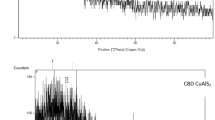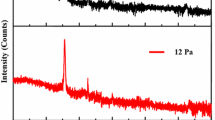Abstract
Crystalline Cu2O and CuO thin films were synthesized by pulsed laser deposition on fused silica substrates at three O2 partial pressures (0.1 Pa, 1 Pa and 10 Pa) and the effects of O2 pressure on the phase formation, structural, optical, surface morphology, wettability and electrical properties of films were characterized by grazing-incidence X-ray diffraction (GIXRD), field emission scanning electron microscopy (FESEM), atomic force microscopy (AFM), UV–visible, FTIR, Raman and photoluminescence (PL) spectroscopy, water contact angle measurements and two-probe electrical studies. GIXRD and Raman studies revealed that the film prepared at 0.1 Pa is a mixed phase of Cu and Cu2O, while the films prepared at higher O2 pressure of 1 Pa and 10 Pa are single-phase CuO. The optical bandgap of the films decreases from 3.00 eV to 2.82 eV with the conversion of Cu2O into CuO. PL studies show strong luminescence peaks at 486 nm (blue), 503 nm (green) and 613 nm (red). The surface roughness of the films decreases with an increase in O2 pressure from 0.1 Pa to 10 Pa. All films are hydrophilic and the hydrophilicity decreases with an increase in O2 pressure. The surface electrical resistivities of films deposited at 0.1 Pa, 1 Pa and 10 Pa O2 pressure are 1.6 × 102, 6.4 × 104 and 1.0 × 104 Ω cm, respectively. It is found that copper oxide phase formation and its properties can be significantly modified by varying O2 pressure during PLD.












Similar content being viewed by others
Availability of data and material
The data on the samples reported in the manuscript are available from the authors.
References
B. Xu, J. Zhou, Z. Ni, C. Zhang, C. Lu, Solar Energy Materials and Solar Cells Synthesis of novel microencapsulated phase change materials with copper and copper oxide for solar energy storage and photo-thermal conversion. Sol. Energy Mater. Sol. Cells. 179, 87–94 (2018). https://doi.org/10.1016/j.solmat.2018.02.008
J. Zhang, J. Liu, Q. Peng, X. Wang, Nearly monodisperse Cu2O and CuO nanospheres: preparation and applications for sensitive gas sensors. Chem. Mater. 18(4), 867–871 (2006)
A. Ulyankina, I. Leontyev, O. Maslova, M. Allix, A. Rakhmatullin, N. Nevzorova, R. Valeev, G. Yalovega, N. Smirnova, Materials science in semiconductor processing copper oxides for energy storage application: novel pulse alternating current synthesis. Mater. Sci. Semicond. Process. (2017). https://doi.org/10.1016/j.mssp.2017.08.001
M. Kaur, A. Tovstolytkin, G. Singh, Magnetoelectric coupling in CuO nanoparticles for spintronics applications. Electron. Mater. Lett. 14, 370–375 (2018). https://doi.org/10.1007/s13391-018-0026-1
D. Wojcieszak, A. Obstarczyk, E. Man’kowska, M. Mazur, D. Kaczmarek, K. Zakrzewska, P. Mazur, J. Domaradzki, Thermal oxidation impact on the optoelectronic and hydrogen sensing properties of p-type copper oxide thin films. Mater. Res. Bull. (2021). https://doi.org/10.1016/j.materresbull.2021.111646
F. Teng, W. Yao, Y. Zheng, Y. Ma, Y. Teng, Chemical Synthesis of flower-like CuO nanostructures as a sensitive sensor for catalysis. Sens. Actuators B 134, 761–768 (2008). https://doi.org/10.1016/j.snb.2008.06.023
N. Verma, N. Kumar, Synthesis and biomedical applications of copper oxide nanoparticles: an expanding. Horizon (2019). https://doi.org/10.1021/acsbiomaterials.8b01092
Y. Xu, K. Chu, Z. Li, S. Xu, G. Yao, P. Niu, F. Zheng, Porous CuO@C composite as high-performance anode materials for lithium-ion batteries. Dalt. Trans. 49, 11597–11604 (2020). https://doi.org/10.1039/d0dt02493g
D.P. Dubal, D.S. Dhawale, R.R. Salunkhe, V.S. Jamdade, C.D. Lokhande, Fabrication of copper oxide multilayer nanosheets for supercapacitor application. J Alloys Compds. 492, 26–30 (2010). https://doi.org/10.1016/j.jallcom.2009.11.149
G. Chen, J.-M. Langlois, Y. Guo, W.A. Goddard, Superconducting properties of copper oxide high-temperature superconductors. Proc. Natl. Acad. Sci. U.S.A. 86, 3447–3451 (2021)
R.K. Jain, A. Khanna, CuO-doped WO3 thin film H2S sensors. Sens. Actuators, B Chem. 343, 130153 (2021). https://doi.org/10.1016/j.snb.2021.130153
F. Marabelli, G.B. Parravicini, F. Salghetti-Drioli, Optical gap of CuO. Phys. Rev. B 52, 1433–1436 (1995). https://doi.org/10.1103/PhysRevB.52.1433
J. Ghijsen, L.H. Tjeng, J.V. Elp, H. Eskes, Electronic structure of Cu2O and CuO. Phys. Rev. B 38, 11322–11330 (1988). https://doi.org/10.1063/1.1725063
S. Ghosh, D.K. Avasthi, P. Shah, V. Ganesan, A. Gupta, D. Sarangi, R. Bhattacharya, W. Assmann, Deposition of thin films of different oxides of copper by RF reactive sputtering and their characterization. Vacuum 57, 377–385 (2000)
Y.S. Gong, C. Lee, C.K. Yang, Atomic force microscopy and Raman spectroscopy studies on the oxidation of Cu thin films. J. Appl. Phys. 77, 5422–5425 (1995)
L.S. Huang, S.G. Yang, T. Li, B.X. Gu, Y.W. Du, Y.N. Lu, S.Z. Shi, Preparation of large-scale cupric oxide nanowires by thermal evaporation method. J. Cryst. Growth. 260, 130–135 (2004). https://doi.org/10.1016/j.jcrysgro.2003.08.012
Z.Q. Yu, C.M. Wang, M.H. Engelhard, P. Nachimuthu, D.E. McCready, I.V. Lyubinetsky, S. Thevuthasan, Epitaxial growth and microstructure of Cu2O nanoparticle/thin films on SrTiO3(100). Nanotechnology 18, 115601 (2007). https://doi.org/10.1088/0957-4484/18/11/115601
F. Oba, F. Ernst, Y. Yu, R. Liu, H.M. Kothari, J.A. Switzer, Epitaxial growth of cuprous oxide electrodeposited onto semiconductor and metal substrates. J. Am. Ceram. Soc. 88, 253–270 (2005). https://doi.org/10.1111/j.1551-2916.2005.00118.x
Y.S. Jung, K.H. Kim, Effects of post-annealing treatment on the properties of reactive sputtered cuprous-oxide. Thin Films 67, 1013–1017 (2015). https://doi.org/10.3938/jkps.67.1013
N.A. Raship, M.Z. Sahdan, F. Adriyanto, M.F. Nurfazliana, A.S. Bakri, Effect of annealing temperature on the properties of copper oxide films prepared by dip coating technique. AIP Conf. Proc. (2017). https://doi.org/10.1063/1.4968374
M. Basu, A.K. Sinha, M. Pradhan, S. Sarkar, Y. Negishi, T. Pal, Fabrication and functionalization of CuO for tuning superhydrophobic thin film and cotton wool. J. Phys. Chem. C. 115, 20953–20963 (2011). https://doi.org/10.1021/jp206178x
F.M. Chang, S.L. Cheng, S.J. Hong, Y.J. Sheng, H.K. Tsao, Superhydrophilicity to superhydrophobicity transition of CuO nanowire films. Appl. Phys. Lett. 96, 96–99 (2010). https://doi.org/10.1063/1.3360847
K. Tang, X. Wang, W. Yan, J. Yu, R. Xu, Fabrication of superhydrophilic Cu2O and CuO membranes. J. Memb. Sci. 286, 279–284 (2006). https://doi.org/10.1016/j.memsci.2006.10.005
S. Sonia, P. Suresh Kumar, N.D. Jayram, Y. Masuda, D. Mangalaraj, C. Lee, Superhydrophobic and H2S gas sensing properties of CuO nanostructured thin films through a successive ionic layered adsorption reaction process. RSC Adv. 6, 24290–24298 (2016). https://doi.org/10.1039/c6ra00209a
M. Pei, B. Wang, Y. Tang, X. Zhang, H. Yan, X. Zhang, Preparation of Cu2O superhydrophobic film with hierarchical structure via the facile route. Asian J. Chem. 26, 315–318 (2014). https://doi.org/10.14233/ajchem.2014.15371
Q. Pan, H. Jin, H. Wang, Fabrication of superhydrophobic surfaces on interconnected Cu(OH)2 nanowires via solution-immersion. Nanotechnology (2007). https://doi.org/10.1088/0957-4484/18/35/355605
M. Hari Prasad Reddy, J.F. Pierson, S. Uthanna, Structural, surface morphological, and optical properties of nanocrystalline Cu2O and CuO films formed by RF magnetron sputtering: Oxygen partial pressure effect, Phys. Status Solidi Appl. Mater. Sci. 209 (2012) 1279–1286. https://doi.org/10.1002/pssa.201127627.
S.B. Ogale, P.G. Bilurkar, N. Mate, S.M. Kanetkar, N. Parikh, B. Panaik, Deposition of copper oxide thin films on different substrates by pulsed excimer laser ablation. J. Appl. Phys. 72, 3765–3769 (1992)
R.K. Jain, J. Kaur, S. Arora, A. Kumar, A.K. Chawla, A. Khanna, Effects of oblique angle deposition on structural, electrical and wettability properties of Bi thin films grown by thermal evaporation. Appl. Surf. Sci. 463, 45–51 (2019). https://doi.org/10.1016/j.apsusc.2018.08.200
F. Baig, Y.H. Khattak, B.M. Soucase, S. Beg, S. Ullah, Effect of anionic bath temperature on morphology and photo electrochemical properties of Cu2O deposited by SILAR. Mater. Sci. Semicond. Process. 88, 35–39 (2018). https://doi.org/10.1016/j.mssp.2018.07.031
J. Kaur, R.K. Jain, A. Khanna, A.K. Chawla, Effects of thickness on the wettability and electrical properties of Sn thin films. J. Vac. Sci. Technol. B 39(1–7), 032205 (2021). https://doi.org/10.1116/6.0001026
S. Chacko, N. Sajeeth, K.G. Gopchandran, P. Koshy, V.K. Vaidyan, Nanostructural and surface morphological evolution of chemically sprayed SnO2 thin films. Appl. Surf. Sci. 254, 2179–2186 (2008). https://doi.org/10.1016/j.apsusc.2007.09.027
E. Kroumova, M.L. Aroyo, J.M. Perez-Mato, A. Kirov, C. Capillas, S. Ivantchev, H. Wondratschek, Bilbao Crystallographic Server: Useful databases and tools for phase-transition studies. Phase Trans. 76, 155–170 (2003). https://doi.org/10.1080/0141159031000076110
L. Debbichi, J.F. Pierson, Vibrational Properties of CuO and Cu4O3 from First-Principles Calculations, and Raman and Infrared Spectroscopy. J. Phys. Chem. C. 116, 10232–10237 (2012)
K. Reimann, K. Syassen, Raman scattering and photoluminescence in Cu2O under hydrostatic pressure. Phys. Rev. B. 39, 113–119 (1989)
M.A. Dar, Y.S. Kim, W.B. Kim, J.M. Sohn, H.S. Shin, Structural and magnetic properties of CuO nanoneedles synthesized by hydrothermal method. Appl. Surf. Sci. 254, 7477–7481 (2008). https://doi.org/10.1016/j.apsusc.2008.06.004
R. Shabu, A. Moses Ezhil Raj, C. Sanjeeviraja, C. Ravidhas, Assessment of CuO thin films for its suitablity as window absorbing layer in solar cell fabrications. Mater. Res. Bull. 68, 1–8 (2015). https://doi.org/10.1016/j.materresbull.2015.03.016
A. Aslani, V. Oroojpour, CO gas sensing of CuO nanostructures, synthesized by an assisted solvothermal wet chemical route. Physica B 406, 144–149 (2011). https://doi.org/10.1016/j.physb.2010.09.038
X. Zhao, P. Wang, Z. Yan, N. Ren, Room temperature photoluminescence properties of CuO nanowire arrays. Opt. Mater. 42, 544–547 (2015). https://doi.org/10.1016/j.optmat.2014.12.032
V. Figueiredo, E. Elangovan, G. Gonçalves, P. Barquinha, L. Pereira, N. Franco, E. Alves, R. Martins, E. Fortunato, Effect of post-annealing on the properties of copper oxide thin films obtained from the oxidation of evaporated metallic copper. Appl. Surf. Sci. 254, 3949–3954 (2008). https://doi.org/10.1016/j.apsusc.2007.12.019
C.S. McCamy, Correlated color temperature as an explicit function of chromaticity coordinates. Color Res. Appl. 17, 142–144 (1992). https://doi.org/10.1002/col.5080170211
P. Suthanthirakumar, K. Marimuthu, Investigations on spectroscopic properties of Dy3+ doped zinc telluro-fluoroborate glasses for laser and white LED applications. J. Mol. Struct. 1125, 443–452 (2016). https://doi.org/10.1016/j.molstruc.2016.06.080
K.V. Krishnaiah, K.U. Kumar, C.K. Jayasankar, Spectroscopic properties of Dy3+-doped oxyfluoride glasses for white light emitting diodes. Mater. Express. 3, 61–70 (2013). https://doi.org/10.1166/mex.2013.1094
X. Hu, F. Gao, Y. Xiang, H. Wu, X. Zheng, J. Jiang, J. Li, H. Yang, S. Liu, Influence of oxygen pressure on the structural and electrical properties of CuO thin films prepared by pulsed laser deposition. Mater. Lett. 176, 282–284 (2016). https://doi.org/10.1016/j.matlet.2016.04.055
W. Reichardt, F. Gompf, M. Ain, B.M. Wanklyn, Lattice dynamics of cupric oxide. J. Phys. Condens. Matter 81, 19–24 (1990)
X.K. Chen, J.C. Iwrin, Evidence for a strong spin-phonon interaction in cupric oxide. Phys. Rev. B. 52, 130–133 (1995)
Acknowledgements
Atul Khanna acknowledges Council for Scientific and Industrial Research (CSIR), New Delhi, India, for a research grant (03(1399)/17/EMR-II). Jatinder Kaur thanks CSIR for research fellowship.
Funding
Council for Scientific and Industrial Research (CSIR), New Delhi, India is acknowledged for a research grant (03(1399)/17/EMR-II).
Author information
Authors and Affiliations
Contributions
AK conceptualized the research problem and planned the experiments. JK, RK and RC prepared thin film samples by pulsed laser deposition. JK characterized the samples by electrical resistivity, optical absorption, Raman and photoluminescence, X-ray diffraction, AFM and FESEM studies. The wettability studies were carried out by RK and RC. The data analysis was done by JK and AK. The manuscript writing and editing was done by JK and AK.
Corresponding author
Ethics declarations
Conflict of interest
The authors declare that they have no known competing financial interests or personal relationships that could have appeared to influence the work reported in this paper.
Additional information
Publisher's Note
Springer Nature remains neutral with regard to jurisdictional claims in published maps and institutional affiliations.
Rights and permissions
About this article
Cite this article
Kaur, J., Khanna, A., Kumar, R. et al. Growth and characterization of Cu2O and CuO thin films. J Mater Sci: Mater Electron 33, 16154–16166 (2022). https://doi.org/10.1007/s10854-022-08506-0
Received:
Accepted:
Published:
Issue Date:
DOI: https://doi.org/10.1007/s10854-022-08506-0




